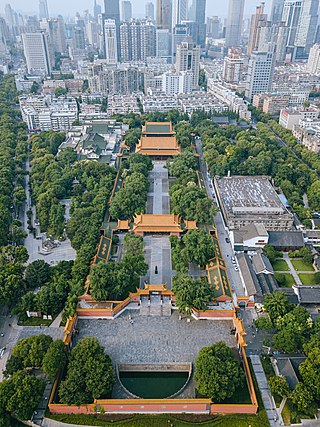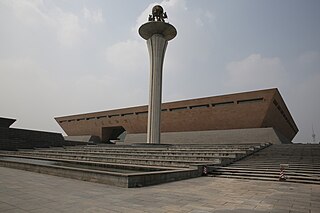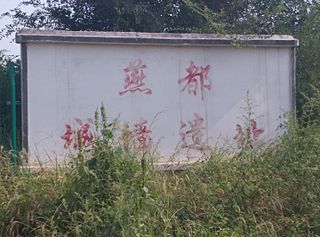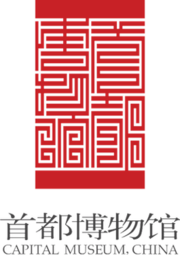
The National Palace Museum is a museum in Taipei, Taiwan. It has a permanent collection of nearly 700,000 pieces of Chinese artifacts and artworks, many of which were moved from the Palace Museum in the Forbidden City as well as five other institutions in mainland China during the ROC retreat. These collections had been transferred to several locations before finally being established in 1965 at its present location in Shilin, Taipei. The museum building itself was built between March 1964 and August 1965, with many subsequent expansions making it one of the largest of its type in the world, including a southern branch located in Taibao, Chiayi.

The Forbidden City is a palace complex in Dongcheng District, Beijing, China, at the center of the Imperial City of Beijing. It is surrounded by numerous opulent imperial gardens and temples including the 22 ha (54-acre) Zhongshan Park, the sacrificial Imperial Ancestral Temple, the 69 ha (171-acre) Beihai Park, and the 23 ha (57-acre) Jingshan Park. It is officially administered by the Palace Museum.

The Palace Museum is a large national museum complex housed in the Forbidden City at the core of Beijing, China. With 720,000 square metres, the museum inherited the imperial royal palaces from the Ming and Qing dynasties of China and opened to the public in 1925 after the last Emperor of China was evicted.

Shaanxi History Museum, which is located to the northwest of the Giant Wild Goose Pagoda in the ancient city Xi'an, in the Shaanxi province of China, is one of the first huge state museums with modern facilities in China and one of the largest. The museum houses over 370,000 items, including murals, paintings, pottery, coins, as well as bronze, gold, and silver objects. The modern museum was built between 1983 and 2001 and its appearance recalls the architectural style of the Tang dynasty.

Yinxu is the site of one of the ancient and major historical capitals of China. It is the source of the archeological discovery of oracle bones and oracle bone script, which resulted in the identification of the earliest known Chinese writing. The archeological remnants known as Yinxu represent the ancient city of Yin, the last capital of China's Shang dynasty which existed through eight generations for 255 years, and through the reign of 12 kings. Yinxu was discovered, or rediscovered, in 1899. It is now one of China's oldest and largest archeological sites, and was selected as a UNESCO World Heritage Site in 2006. Yinxu is located in northernmost Henan province near the modern city of Anyang, and near the Hebei and Shanxi province borders. Public access to the site is permitted.

Sanxingdui is an archaeological site and a major Bronze Age culture in modern Guanghan, Sichuan, China. Largely discovered in 1986, following a preliminary finding in 1927, archaeologists excavated artifacts that radiocarbon dating placed in the twelfth–eleventh centuries BC. The archaeological site is the type site for the Sanxingdui culture that produced these artifacts, archeologists have identified the locale with the ancient kingdom of Shu. The artifacts are displayed in the Sanxingdui Museum located near the city of Guanghan.

Beihai Park is a public park and former imperial garden immediately northwest of the Forbidden City in Beijing, China.

The National Museum of Indonesia is an archeological, historical, ethnological, and geographical museum located in Jalan Medan Merdeka Barat, Central Jakarta, right on the west side of Merdeka Square. Popularly known as the Elephant Museum after the elephant statue in its forecourt, its broad collections cover all of Indonesia's territory and almost all of its history. The museum has endeavoured to preserve Indonesia's heritage for two centuries.

The Guoqing Temple is a Buddhist temple on Mount Tiantai, in Taizhou, Zhejiang Province, China. Originally built in 598 CE during the Sui dynasty, and renovated during the reign of the Qing Yongzheng Emperor, the temple is located roughly 220 kilometres (140 mi) from the city of Hangzhou. It was the initial site for the creation of the Tiantai school of Mahāyāna Buddhism, founded by the Chinese Buddhist teacher Zhiyi. The temple covers an area of some 23,000 m2 (250,000 sq ft) and features 600 rooms in a total of 14 different halls, including the Grand Hall of Sakyamuni, the Hall of Five Hundred Arhats and the Hall of Monk Jigong. The exterior of the building features Chinese pagodas such as the Sui Pagoda, the Seven Buddha Pagoda, and the Memorial Pagoda of Monk Yi Xing.

The Wanshou Temple is a temple located at No.121, Wanshousi Road, Zizhuyuan Subdistrict, Haidian District, Beijing. In addition to being a Buddhist temple, the Wanshou Temple also houses the Beijing Art Museum.
The National Administration of Cultural Heritage is an administrative agency affiliated with the Ministry of Culture and Tourism of the People's Republic of China. It is responsible for the development and management of museums as well as the protection of cultural relics of national importance.

The Hall of Mental Cultivation is a building in the inner courtyard of the Forbidden City in Beijing, China. The hall is a wooden structure with dome coffered ceilings, and was first built during the Ming dynasty in 1537, and was reconstructed during the Qing dynasty. During the early Qing dynasty under the reign of the Kangxi Emperor the hall was mostly used as a workshop, wherein artisan objects like clocks were designed and manufactured. From the reign of the Yongzheng Emperor during the 18th century, the hall was the residence for the emperor. Under the reign of the Qianlong Emperor until the fall of the Qing dynasty, the hall became the centre of governance and political administration. In the Western Warmth Chamber, the emperor would hold private meetings, and discuss state affairs with his mandarins. After the death of Emperor Xianfeng, from inside the Eastern Warmth Chamber, empress dowagers Ci'an and Cixi would hold audiences with ministers and rule from behind a silk screen curtain during their regencies for emperors Tongzhi and Guangxu, who both succeeded to the throne as children in the second half of the 19th century.

The Chaotian Palace, is located in Nanjing, China. It was built as an imperial palace in the Ming dynasty, and today it is known as the Nanjing Municipal Museum. Chaotian Palace area has the largest preserved traditional Chinese architectural complex in Jiangnan.

The China pavilion at Expo 2010 in Pudong, Shanghai, colloquially known as the Oriental Crown, was the largest national pavilion at the Shanghai Expo and the largest display in the history of the World Expo. It was also the most expensive pavilion at the Shanghai Expo, having cost an estimated US$220 million. The pavilion showcased China's civilization and modern achievements by combining traditional and contemporary elements in its architecture, landscaping and exhibits. After the end of the Expo 2010, the building was converted to a museum. On October 1, 2012, it was reopened as the China Art Museum, the largest art museum in Asia.

Luoyang Museum is a historical museum in Luoyang, Henan Province, China. Situated in the Yellow River valley. It offers exhibits of the rich cultural heritage of Luoyang, a major Chinese cultural centre, which was the capital of numerous Chinese dynasties including the Eastern Zhou and the Eastern Han.

The Western Zhou Yan State Capital Museum is an archaeological museum in southwestern Beijing Municipality at the site of the capital of the ancient State of Yan during the Western Zhou dynasty. The site is located in Dongjialin Village, just north of Liulihe Township (琉璃河镇), in Fangshan District, 43 km (27 mi) south of Beijing's city centre. During the Western Zhou dynasty, over 3,000 years ago, the walled settlement at Liulihe, as the site is also known, served as the capital of the Yan, a vassal state of the Zhou dynasty. The discovery of the site in 1962 is considered to be one of the 100 major archaeological discoveries in China during the 20th century. Artifacts from the site including engraved bronze ware and chariots provide the earliest archaeological evidence of urban settlement in Beijing Municipality. The museum at the site, operated by the municipal government, opened in 1995.
Guangfulin is an archaeological site in Songjiang District, Shanghai, China. It is estimated to be over 5,000 years old. Artifacts from the Zhou Dynasty have also been unearthed at the site. The site covers 250 square kilometers. It was announced to be the Shanghai Cultural Relics Protection Site in December 1977, and was approved by the state council as one of the seventh batch of National Key Cultural Relics Protection Units in May 2013. The Guangfulin Relics Park is under construction.

The Houmuwu ding, formerly called Simuwu ding, is a rectangular bronze ding of the ancient Chinese Shang dynasty. It is the heaviest piece of bronzeware to survive from anywhere in the ancient world. It was unearthed in 1939 in Wuguan Village, Anyang, Henan, near Yinxu, the site of the last Shang dynasty capital.





















